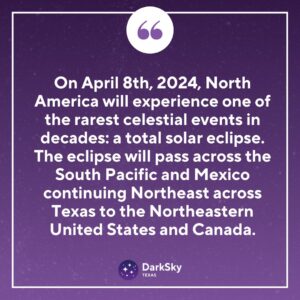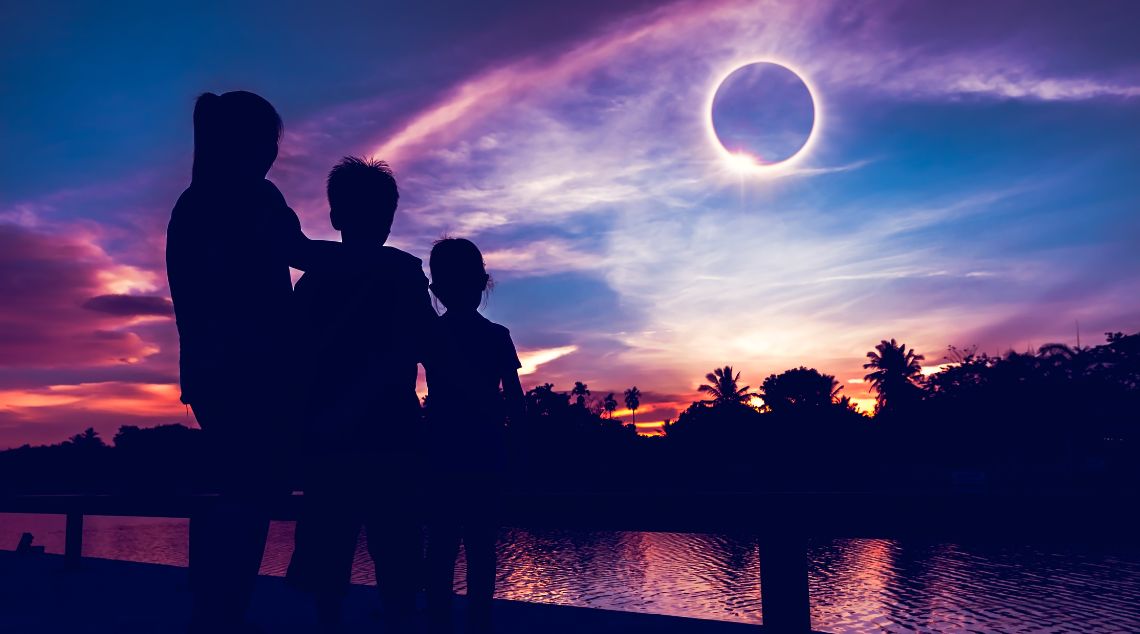On April 8th, 2024, North America will experience one of the rarest celestial events in decades: a total solar eclipse. The eclipse will pass across the South Pacific and Mexico continuing Northeast across Texas towards the Northeastern United States and Canada.
However, the period of totality will be longest in Mexico and Texas – and thanks to its generally clear spring skies and years of light pollution activism, Texas is gearing up as the prime location for astronomers and eclipse hunters.
Eclipses 101
Eclipses occur when one celestial body (a moon, a planet like Mars, or a star like the Sun) moves into the shadow of another.
From time to time, we can see one of two types of eclipses from Earth:
- Lunar eclipses occur when the Earth moves between the Sun and the Moon. As the Moon does not emit its own light, during a lunar eclipse the earth’s shadow will block any reflected sunlight from reaching the Moon, causing it to go dark.
- A solar eclipse occurs when the Moon’s path places it between the Sun and the Earth, casting its shadow on a small area of the Earth. Those standing beneath the Moon’s shadow will see the solar eclipse.
Either type of eclipse can be partial or total. During a partial eclipse, the Moon, Earth, and Sun are not completely aligned, so part of the Moon or Sun will always remain visible. However, during a total eclipse, if you’re standing in the right region, you may see the entire Sun or Moon disappear completely.
Total eclipses are much rarer than partial ones. There are between two and five partial solar eclipses every year and at least two partial lunar eclipses as seen from somewhere on the earth’s surface. But total eclipses happen less than once a year, and many are only visible from the ocean or inaccessible areas.
Why Is This Total Solar Eclipse a Big Deal?
On average, Earth sees a total solar eclipse approximately every 18 months. And yet, most of these don’t get the same attention as the one we will see on April 8th.
That’s because this year’s event will happen just as the Moon is closest to the Earth. This means that the shadow projected by the Moon will be much larger, causing a larger area to experience total or near-total darkness. It will also last longer and cover a heavily populated area.
This requires perfect timing for a precise alignment – and it will not happen in the contiguous United States again until 2044.
Want in? Here’s How to View the Eclipse
Almost every Texas astronomy fan will likely stop what they’re doing the day of the eclipse. This may be a once-in-a-lifetime opportunity for many of us, yet some preparation is needed before you can enjoy your front-seat view.
1. Research safety methods
The first obstacle? You must use proper eclipse glasses or welder’s glass to view the eclipse before and after totality. Looking directly into the sun can permanently damage your eyes. A standard set of sunglasses or even a regular camera lens will not protect you.
DO NOT try to look at the sun without eclipse glasses through binoculars, your phone’s camera, or a telescope. You could be partially blinded for life!
2. Get the right gear
To watch the eclipse safely, you’ll need to use either:
- Special eclipse glasses certified to the ISO 12312-2 international safety standards to be safe. Beware of the many counterfeits that are sold online!
- A pinhole projector, where you can see the sun’s reflection through a pinhole (such as a colander or a hole in an index card).

Beware: this does not mean you should look through the pinhole, as this will offer no protection. Instead, you’ll have to turn your back to the sun and let the sunlight pass through the pinhole into any smooth surface – such as a sandy beach or a white piece of paper.
Then, you will be able to “see” the eclipse on the reflected surface and track its progress by looking at the shadow: as it advances, the circle of light will shrink and become a crescent first, and then just a ring of light.
3. Choose a dark place
In many urbanized areas, the sudden darkness may accidentally bring out more light: street lights, car lights, and some private lighting may use light sensors to turn themselves on automatically as soon as it gets dark. These can easily get in the way of your eclipse viewing and pinhole reflection!
Instead, head somewhere away from light pollution. Many experienced “eclipse hunters” already have dark spots chosen away from the cities, in natural parks or dark sky reserves. This also gives you a great opportunity to get away from routine a bit: listen to insects and birds, and watch how they adapt to sudden darkness. This will help you understand the impact of artificial lights on them!
What will you experience before, during and after the eclipse?
1. Before the Eclipse
The Sun will be about 65 degrees high in the southwestern sky, so find an unobstructed view. Bring your eclipse glasses, a hat, sunscreen, and an easy chair.
As for photography, there is a lot of information on the web about photographing the eclipse. There is a product called Solar Snap to shoot through iPhones. You can find it at the Apple and Google app stores and order the filters through the app.
2. Before Totality
Across Texas the timing of the eclipse will vary according to location starting shortly after noon until around 12:30 PM. You can sit and watch all 80 minutes of this until Totality (using your eclipse glasses). Observe the Sun only through your eclipse glasses until Totality begins and again after Totality ends.
3. Shortly Before Totality
About 30 seconds before Totality begins, look to the southwest to see the Moon’s dark shadow approaching. Darkness will fall rather suddenly. The temperature may drop.
4. During Totality
First, take off your eclipse glasses.
You will be in a dark twilight. The sky toward the eclipsed Sun will be dark, but you will still see blue skies toward the horizons. Bright Venus will be visible below and a little to the right of the Sun. Bright Jupiter will be visible above and to the left of the Sun. Some stars may be visible. Near Jupiter you may be able to catch a glimpse of Comet 12P/Pons-Brooks with binoculars.
The Sun’s white corona and red chromosphere will be visible surrounding the black hole where the Sun is hidden. With good luck, you will see reddish solar prominences extending outward from the chromosphere in silhouette against the dark sky. All of these are usually lost in the solar glare.
Mountains along the Moon’s rim can momentarily block the Sun while lunar valleys along the rim allow small beads of sunlight to shine through.This is known as Baily’s Beads. At the beginning or end of Totality, when only a few beads are left, the last rays may create a brief, brilliant flash. This rarer event is known as a Diamond Ring.
Note the size and shape of the corona. The Sun’s energy output varies in an eleven-year cycle, and this affects the corona. In max years, the corona is larger and uniform in thickness, while the minimum corona is smaller and flattened on the sides. 2024 is near the maximum for this solar cycle and there should be a large corona extending uniformly around the Sun.
Finally, be aware of the effect of Totality on nature, people, and you. It is a magical time. Savor it.
5. After Totality
The second sunlight reappears, put your eclipse glasses back on. Look northeast to see the shadow receding to the northeast as Totality ends.
Ready to Learn More? Resources and Tips
Eclipses offer an unusual combination of beauty, adventure, and science. They’re an excellent opportunity to learn more about physics and astronomy, study animal behavior, or simply stop in awe at nature’s grandeur.
Want to learn more? Watch what Dr. Patricia Reiff from Rice University has to say about eclipses. Use this map to check possible observing locations. It will also give you the time and duration of Totality.


